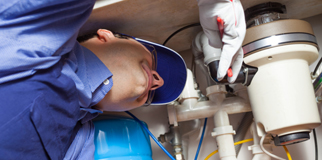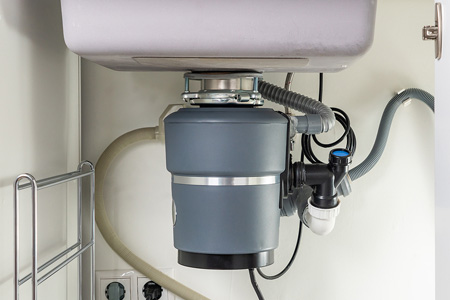Best Tips for Fixing a Leaking Waste Disposal Unit
Best Tips for Fixing a Leaking Waste Disposal Unit
Blog Article
Almost everyone will have their own unique beliefs about Garbage Disposal Leaking From Bottom.

Garbage disposals are essential kitchen area home appliances that help in dealing with food waste successfully. Nevertheless, a leaking waste disposal unit can be a frustrating and unpleasant problem to handle. The good news is, numerous leakages can be fixed quickly with a couple of easy actions. In this article, we will go over how to repair a leaking garbage disposal successfully.
Intro
Garbage disposals are installed under kitchen area sinks and are created to shred food waste right into smaller sized items, enabling it to go through the pipes system conveniently. While these devices are normally trusted, leakages can occur gradually as a result of wear and tear, loosened links, or damages to the unit.
Usual Reasons For Leakages in Trash Disposals
Worn Seals and Gaskets
Seals and gaskets play an essential duty in avoiding water from dripping out of the waste disposal unit. In time, these parts can deteriorate, resulting in leakages around the disposal device.
Loose Connections
The connections between the waste disposal unit and the pipes system can come to be loosened over time, causing water to leak out during operation.
Splits or Holes in the Disposal System
Physical damage to the waste disposal unit, such as cracks or openings in the real estate, can likewise cause leaks.
Determining the Source of the Leak
Prior to attempting to fix a dripping waste disposal unit, it is necessary to recognize the source of the leak. This can normally be done through visual assessment or by performing simple tests.
Visual Assessment
Evaluate the waste disposal unit unit very carefully for any kind of indicators of water leak. Pay very close attention to areas around seals, gaskets, and link points.
Evaluating for Leakages
One means to check for leaks is by running water via the disposal unit and looking for any kind of visible indications of leakage.
Tools and Products Needed for Dealing With a Leaking Waste Disposal Unit
Before beginning the fixing process, gather the needed tools and materials, consisting of a screwdriver, flexible wrench, plumber's putty, replacement seals or gaskets, and epoxy or patching material for repairing fractures or holes.
Step-by-Step Guide to Taking Care Of a Dripping Garbage Disposal
Turn Off the Power
Before attempting any kind of repairs, ensure that the power to the waste disposal unit device is switched off to stop the danger of electrical shock.
Find the Leak
Identify the exact area of the leak and identify the reason.
Tighten up Connections
Make use of a wrench to tighten up any kind of loose connections in between the disposal unit and the plumbing system.
Change Seals or Gaskets
If the leakage is due to worn seals or gaskets, eliminate the old elements and change them with new ones.
Patching Fractures or Openings
For fractures or openings in the disposal system, usage epoxy or an ideal patching product to secure the broken location.
Checking the Waste Disposal Unit After Repair Service
As soon as the repair service is full, check the waste disposal unit by running water with it to guarantee that the leak has been dealt with.
Preventive Maintenance Tips to Stay Clear Of Future Leakages
To avoid future leaks, it is necessary to perform routine upkeep on your waste disposal unit. This includes keeping it clean, avoiding putting non-food items or difficult items down the disposal, and regularly looking for leakages or other problems.
Final thought
In conclusion, repairing a leaking garbage disposal is a fairly straightforward process that can be finished with fundamental tools and products. By adhering to the steps outlined in this write-up and exercising preventive upkeep, you can keep your garbage disposal in good working problem and stay clear of expensive repairs in the future.
HERE’S HOW TO FIX YOUR GARBAGE DISPOSAL
WHAT TO DO IF SOMETHING IS STUCK IN YOUR GARBAGE DISPOSAL
If the impeller won’t turn, there’s probably something stuck in the disposal. It could be a steak bone or peach pit, although plumbers report pulling all sorts of inappropriate objects out of disposals, such as bottle caps or aluminum foil. Make sure power to the disposal is off, and look inside to see if you can see the source of the jam.
Never stick your fingers in a disposal. Pull out anything you see with tongs or pliers.
If the disposal still won’t work, it may be time to call a plumber or consider buying a new disposal. GEM Plumbing & Heating is here for all of your garbage disposal needs.
WHAT TO DO IF YOUR GARBAGE DISPOSAL DRAIN IS CLOGGED
Take everything out from underneath your sink and put a bucket or other container under your disposal to catch any water that drains out. Disconnect your disposal from the power supply. If it’s plugged into a wall outlet, unplug it. If it’s hardwired into an electrical box, go to the electrical panel and turn off the breaker for the disposal. Pour ¼ cup of baking soda into the drain, followed by ½ cup of white vinegar. Give the solution a few minutes to fizz and do its work. Look into the disposal with a flashlight to see if you can see an object that might be causing the clog. If you see it, remove it using tongs or pliers. MORE TIPS ON DEALING WITH A CLOGGED GARBAGE DISPOSAL
Never use drain cleaner in a garbage disposal. It can damage the plastic parts inside the disposal. You can also be splashed with the caustic liquid while working to clear the clog. Beware! Never stick your fingers into a garbage disposal. Trust us — not a good idea. In many instances, your dishwasher drains through your garbage disposal. This allows the disposal to grind any large food particles that may be drained out of your dishwasher. There are some jurisdictions, however, where the plumbing code prohibits such a connection. WHAT TO DO WHEN YOUR DISHWASHER DRAINS THROUGH THE DISPOSAL
Run some water in the sink so your plunger has at least a ½-inch of water to create a seal and plunge vigorously up and down several times. You may need to repeat this several times. Run hot water down the drain to clear any residue that remains.

I discovered that content on How to fix a pretty consistent leak from my garbage disposal when scouting around the search engines. Are you aware of someone else who is sincerely interested in the subject? Why not promote it. I recognize the value of reading our article about Tips on Fixing a Leaking Garbage Disposal.
Schedule Report this page